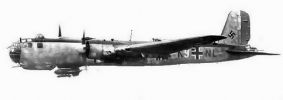
Heinkel He 177521 viewsThe He 177 was a try to devellop a real strategic bomber. The idea to combine two motors on one propeller lead to heavy problems. Due to this and other misstakes in construction, the plane became a deadly trap for many crews and got the the nick-name "Lighter of the Reich". The He 177 saw first operational service in 1942 and was mainly used for maritime warfare in the west. In the mid of 1944 87 He 177 flew an attack on Velikye Luki at the east-front. At the end of the war one machine was modified to carry a german atomic bomb.
Sep 23, 2004
|
|

Dornier 335518 viewsAs the Second World War in Europe drew to a close, a powerful new twin- engined fighter was preparing to enter service with the Luftwaffe. This amazing machine was the piston-engined Dornier Do 335. Fitted with Daimler-Benz DB603A-2 engines delivering 1750 hp at take-off, the first example, Do 335 V1 (CP+UA), flew for the first time on 26 October 1943 from Mengen, Wurttemburg, with Flugkapitan Hans Dieterle at the controls. When the US Army overran the Oberpfaffenhofen factory in late April 1945, only 11 Do 335A-1 single seat fighter-bombers and two Do 335A-12 conversion trainers had been completed. A further nine A-1's, four A-4's and two A- 12's were in final assembly, and components and assemblies for nearly 70 more had been completed. Heinkel at Vienna had been unable to build any Do 335A-6 night fighters.Sep 23, 2004
|
|
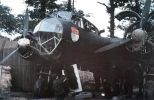
Dornier 17608 viewsThe Dornier 17, were the mainstay of the German bombers during the Blitz on Britain and especially London. Dornier 17 had been an easy target for the Spitfires and Hurricanes of Fighter Command but had proved itself to be a valuable part of the Luftwaffe in campaigns that led up to this battle. The Luftwaffe valued the plane as was shown by production levels for the plane at the start of the war. 1,700 Dornier 17's were built between 1939 and 1940. It made its mark in the attack on Poland in September 1939 and its versatility was such that it was used as a bomber, reconnaissance plane and as a pathfinder by the Luftwaffe. Its limitations were shown in the Battle of Britain, however, when it became clear that the plane was very vulnerable to attacks from the rear and from below and that its defensive armaments were poor. As with other German bombers, against a poor air force, the Dornier 17 did well and the Luftwaffe clearly was over-confident as to its capabilities. Sep 23, 2004
|
|
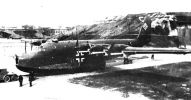
Blohm und Voss BV 222972 viewsWith a wing span of 46 m and six engines the Blohm & Voss BV 222 was the largest flying boat built in the second world war. On 7th August 1941, the BV 222 V2 which, following experience with the V1, was already equipped with suitable defensive weapons, made it's maiden flight. The first flight took place on 7th September 1940, which was after the start of the second world war, when a machine with a long-range capacity and large cargo space was already of special interest to the military. A total of 12 machines were built in different versions. After completion of trials and conversion, the V2 went into service as a troop transporter with LTS See 222 (air transport command sea 222), before it was finally introduced to 1/SAGr. 129 in Biscarosse, France for the long-range reconnaissance purpose for which it was originally intended.Sep 23, 2004
|
|

Blohm und Voss BV 141662 viewsThe Bv-141 was a very unusual, asymmetric aircraft. The configuration was adopted to give excellent all-round view from a single-engine aircraft. An extensively glazed nacelle was fitted to the left of a slender tail boom. The Bv-141A (with symmetrical tailplane) was an excellent aircraft but the RLM rejected it as underpowered. The more powerful Bv-141B (with asymmetrical tailplane) had some handling problems. Both types had hydraulic problems.
Its first flight, on 25 February 1938, proved the Bv-141 to be more airworthy than its detractors wanted to believe. Over the next two years three Bv-141A prototypes and 10 Bv-141B production aircraft were completed, but the poor bird never shook the stigma of its disfigured appearance and the Folke Wulf Fw-189A was the winner of the contract. Sep 23, 2004
|
|
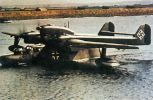
Blohm und Voss BV 138722 viewsThe first prototype which was ready in July 1937 had seveare problems in the air and on the water. A general re-design of the construction followed. Some BV 138 A's were used as transporters for the norwegian campaign in 1940, but late in June 1941 the BV 138 B's saw their service in the role they were constructed for, as sea-reconnaissance planes. From then on they patroled the North-sea and the Arctic-sea and shadowed the well known North-Cape convoys.
The version BV 138 MS was equipped with a mine-sweeping gear and the BV 138 C-1 which was equipped with Radar saw service in anti U-boat attacks.Sep 23, 2004
|
|
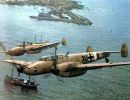
Messerschmitt Bf110668 viewsWilly Messerschmitt however made a creditable attempt with the Bf110, resulting in a machine at that time faster than the Bf109 and similar in speed to the Hawker Hurricane, (end of 1936).
The Bf110 was also tried as a bomber and a night fighter, the latter being its more successful role.
But it must be said that long range, speed, and manoeuvrability, are not mutually compatible and the Bf110 never was more than a maid of all work.Sep 23, 2004
|
|
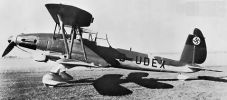
arado ar81599 viewsThe chief rival to the legendary Ju 87, the V3 was superior in most respects but the Ju 87 was chosen primarily due to the fact that the Ju 87 was a monoplane.Sep 23, 2004
|
|
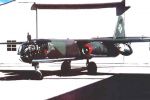
arado ar234510 viewsThe Ar-234 was originally conceived in early 1941 by an engineering team under Professor Walter Blume, director of the Arado aircraft company. Arado projected a maximum speed of 780 KPH (485 MPH), an operating altitude of almost 11,000 meters (36,000 feet), and a maximum range of 2,000 kilometers (1,250 miles). A total of 210 Ar-234Bs and 14 Ar-234Cs were delivered to the Luftwaffe, but with Germany in chaos, only a handful ever got into combat. A final inventory taken on 10 April 1945 listed 38 in service, including 12 bombers, 24 reconnaissance aircraft, and 2 night fighters. These aircraft continued to fight in a scattered and ineffective fashion until Germany surrendered on 8 May 1945. Some were shot down in air combat, destroyed by flak, sometimes their own, or bounced by Allied fighters when they came in to land. Sep 23, 2004
|
|

Arado AR 232A635 viewsThe Luftwaffe's Arado AR 232A combat area transport flew for the first time in the summer of 1941, and was a state-of-art flying machine abounding with technological firsts and innovations.
Performance:
Cruise Speed: 288km/h (180 mph)
Range with max. payload (9,921 lb. (4500kg)): 660 miles (1050km)
Min. field lenth at gross weight: 3,100 ft. (945m)Sep 23, 2004
|
|
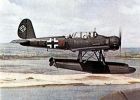
ARADO AR 1961762 viewsthe Ar 196's primary duties consisted of reconnaissance and shadowing of service vessels. While in most respects the Ar 196 is not a formidable aircraft, for a seaplane it's performance exceeded it's Allied counterparts. After Germany's capital ships ceased active participation in the war, most Ar 196's were relegated to sea patrols from shore bases. About 50 planes served with Balkan air forces in the Adriatic and Black Sea.
Variants:
Ar 196A-0, Ar 196A-1, Ar 196A-2: Coastal patrol variant.
Sep 23, 2004
|
|
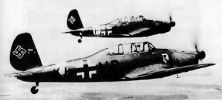
Arado Ar 96685 viewsAdvanced trainer monoplane. At least 11546 built during WWII, and production continued in Czechoslovakia until 1948.
Type: Ar 96B-5
Function: trainer / liaison
Year: Crew: 2 Engines: 1 * 360kW Argus As 10MA-1
Speed: 330km/h Ceiling: 7000m Range: 990km
Armament: 1*mg7.9mm
Sep 23, 2004
|
|
|
|